Topics
- Article
- Sleep
Sleep Efficiency: What is It, How Do You Stack Up & How Can You Improve?
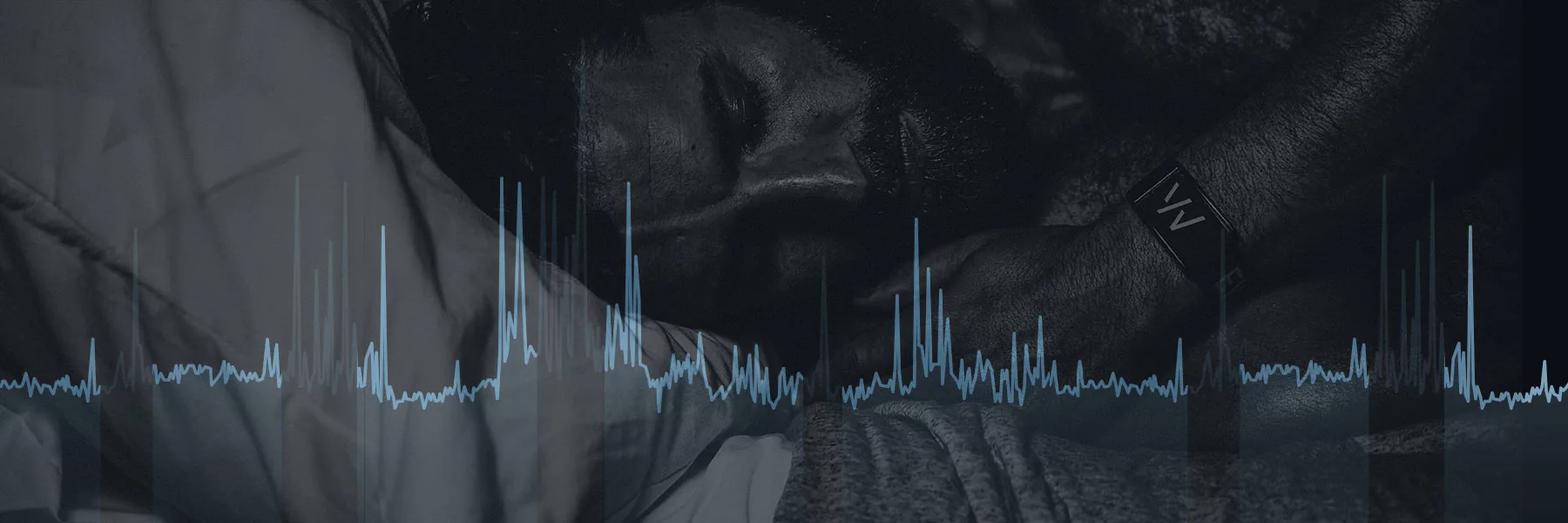
Sleep Efficiency is a simple but powerful metric--the percentage of the time you spend in bed that you are actually asleep.
What is Sleep Efficiency?
How do you calculate Sleep Efficiency? It's a simple but powerful metric--the percentage of the time you spend in bed that you are actually asleep. Sleep Efficiency is therefore a measure of sleep quality, and when considered alongside the rest of the WHOOP sleep pillar metrics, provides actionable insight into where your sleep could improve. Looking at Sleep Efficiency alongside Sleep Performance provides a useful indicator as to where you can best target your sleep-improving efforts. This concept is broken down further:
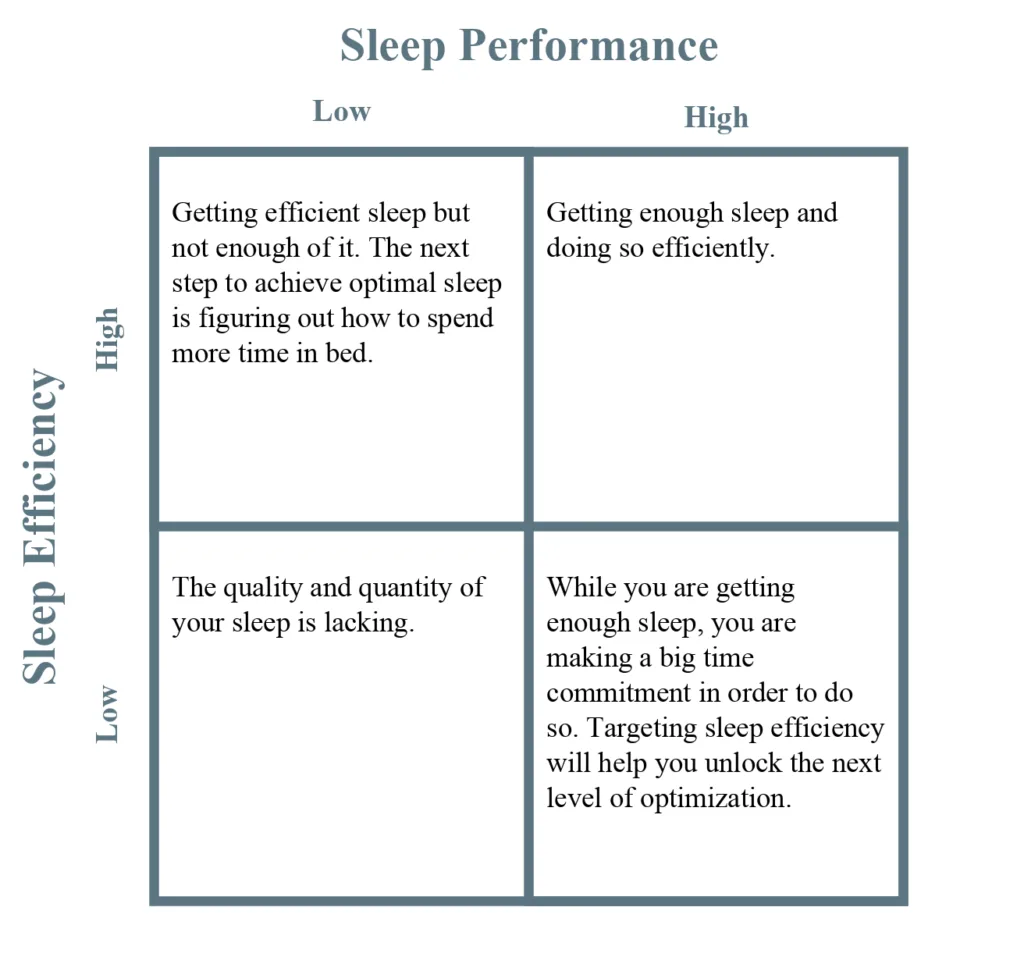
We’ll take a deep dive into Sleep Efficiency, share some original WHOOP research and demographic breakdowns, and also summarize what the world’s best academic sleep researchers have to say on the topic.
Average Sleep Efficiency
Let’s start off by answering a frequently asked question: What’s normal? We pulled the 1-million most recent sleeps recorded by our WHOOP users and plotted them below:
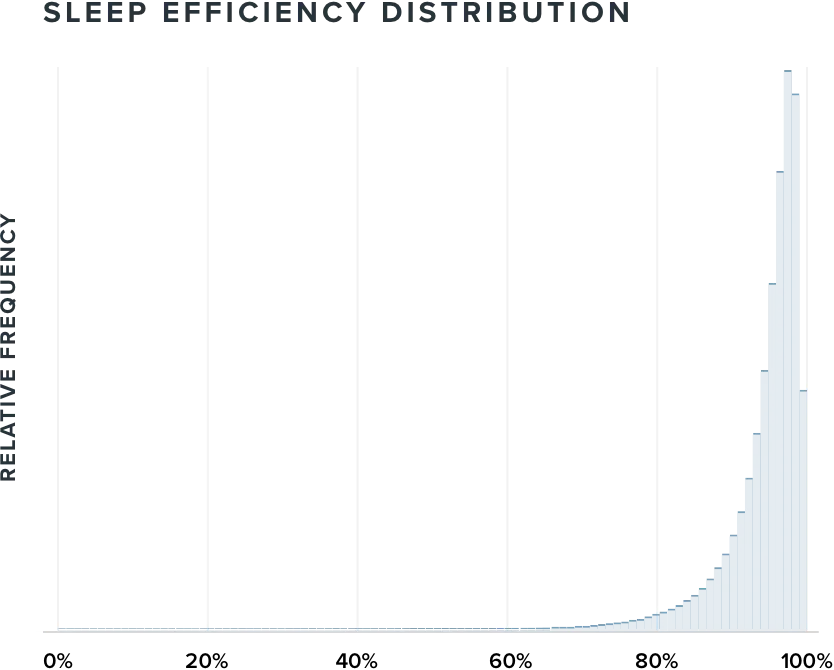
The graph above shows that the average Sleep Efficiency on WHOOP is 94.4%, meaning that for a typical 8-hour time in bed, the average WHOOP user is getting 7 hours and 33 minutes of actual sleep. This value is consistent with what academic sleep literature suggests given that the typical WHOOP user is young and fit, two characteristics which are known to be correlated with increased Sleep Efficiency. For a great review of the topic, check out this 2016 article by Drs. Michael Scullin and Donald Bliwise. Since typical Sleep Efficiency varies quite a bit across demographics, we share some of the breakdowns:
Among WHOOP users, age is highly correlated with Sleep Efficiency, and displays an expected decline as users move from the youngest to oldest age groups. In fact, WHOOP users lose an average of about 1 percentage point of sleep efficiency per decade of added age.
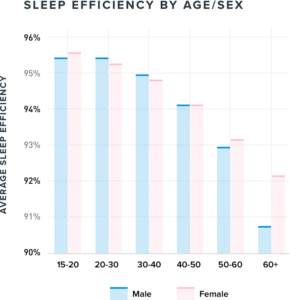
Females on WHOOP sleep more efficiently than males on WHOOP in the youngest and oldest age groups, and sleep marginally less efficiently in their 20s, 30s, and 40s. Interestingly, female Sleep Efficiency is dramatically better than male Sleep Efficiency in our oldest age groups.
Sports, Exercise, and Sleep Efficiency
Day Strain and Sleep Efficiency have an interesting relationship, shown below, in which Sleep Efficiency peaks roughly around a Day Strain of 14 and declines for the lowest and highest Strains. For those readers not familiar with WHOOP, a Strain of 14 is roughly what we expect when a well-trained athlete runs 10k at a moderate effort.
Academic literature confirms that this pattern should be expected, as it’s been studied in both younger and older individuals. While most of the literature focuses on the differences in Sleep Efficiency following no-exercise vs light exercise days (the rise in Sleep Efficiency as Strain increases from 4 to 14), there is also literature supporting the decline in Sleep Efficiency seen when exercise intensity is greatest (the sharper fall as Strain increases beyond 18). One 2011 study demonstrated that following extreme exhaustive exercise, catecholamine (stress hormone) levels are increased and may remain increased for as many as two days, a change that could certainly impact sleep quality. After looking at Sleep Efficiency and the previous day’s Day Strain, we next looked at how Sleep Efficiency varies among different types of athletes, specifically, by their primary sport (the activity they log most frequently on WHOOP). On average, soccer players are the most efficient sleepers and within our 15 most-popular sports, walkers and elliptical users are the least efficient. While the below graph may suggest something interesting about the physiology of those who are best suited for one sport vs another, it is worth mentioning that the actual Sleep Efficiency experienced by a given user is more strongly determined by age, gender, frequency and intensity of exercise, and individual behavioral choices than it is by their primary sport.
Regional Differences in Sleep Efficiency
Sleep Efficiency doesn’t just vary in expected ways, such as with age, but also shows some unexpected variation across geographic regions. We looked at the differences among our domestic and international users for our 12 most-represented countries.
We see in the graph above that European WHOOP users are generally sleeping more efficiently than are those of us in the United States and Canada.
Sleep Efficiency Temporal Patterns
Finally, in conducting the above analysis, we found that Sleep Efficiency, at least within the WHOOP user base, displays cyclical variation.
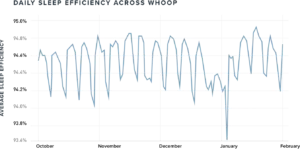
The graph above shows the WHOOP average daily Sleep Efficiency for the last 4 months. There’s a 7-day repeating pattern in which Sleep Efficiency is higher during the work weeks than on the weekends. This pattern can also be seen by binning the data by day of week (below). One thing we found amusing was how the cyclical pattern, which is very strong throughout October and November, breaks down around Thanksgiving and again during the holiday season in late December through New Years.

If we look at time in bed and hours of sleep (below), we see almost the opposite pattern from what we saw with Sleep Efficiency--greater sleep duration and time in bed are experienced on the weekend days. This likely explains the above trend in Sleep Efficiency because, as is demonstrated in a 1996 article published in Sleep, when users sleep late, the extended portion of their sleep tends to be less efficient than the earlier part of the night. It is therefore likely that the beginning of the users’ sleeps on weekends start out roughly equally efficient to any other night, but as they extend sleep past typical wake up times, Sleep Efficiency decreases sufficiently to bring down the overall average for the night.
How to Increase Sleep Efficiency
Regardless of whether you are a young female soccer player with all the demographic advantages, or an older male whose primary activity is walking, the good news is that statistical predictors of Sleep Efficiency are only part of the story. The most significant determinant of it is your behavior. We suggest committing to some of the following changes to improve Sleep Efficiency:
DON'T BE AFRAID OF THE DARK
- Make sure your bedroom is dark enough that you can’t see your fingers when you hold your hand out in front of you.
- Remove or cover up all electronics with those pesky LEDs. While they seem insignificant, it takes as little as 80 lux for your brain to receive “daytime” signals that can inhibit sleep.
- Consider investing in blackout curtains if the light is coming from outside.
BANISH SOUND
- Ensure your room is quiet, or consider earplugs if you can’t remove the noise. One study showed that even relatively low levels of noise decrease sleep quality.
TIMING IS EVERYTHING
- Increasing blue light exposure during the day helps keep your circadian rhythm on track, making it easier to fall asleep and stay asleep at night. As a bonus, this will also help with daytime alertness and performance.
- Conversely, cut out blue light exposure in the evening since increased alertness is no longer what you are after.
- Consider blue light blocking glasses and/or blue light blocking filters for your screened devices. Better yet, turn off those screens completely at least 2 hours before bed.
THINK TWICE ABOUT WHAT GOES IN YOUR MOUTH
- Cut out the caffeine at least 7 hours before bedtime. This not only includes obvious sources like coffee, but also less obvious sources like certain breakfast cereals.
- Don’t eat too much too close to bed. Going to bed with a full stomach can decrease sleep quality and increase sleep latency.
- Consider sleep-promoting foods and drinks like cherry juice and herbal teas, such as chamomile.
SET THE MOOD
- A nighttime ritual helps your body power down.
- Consider meditating or journaling to clear your mind of thoughts that might be keeping you awake.
- Set aside clothes just for sleep. Sleeping in that old t-shirt from college or the undershirt you wore to work sends mixed signals. Having “just for sleep” clothes helps set a tone your sleep hormones understand.
- Maintain the sanctity of your bed; if you bring your work into bed with you (even just that one last email you have to write), you tell your body that bed is for work. Since you would never want to fall asleep at work, your body rallies to stay awake--very counterproductive.
TIPS FROM WHOOP MEMBERS
We polled our 100 best sleepers on WHOOP for their tips and tricks for peak Sleep Performance, below are some of our favorite responses:
- Take several deep breaths when you first get in bed. What we love about this is it only takes 15 seconds, even the busiest readers out there can make time for this one.
- Use a weighted blanket.
- Snuggle your dog. This one surprisingly came up multiple times, so we looked into it. According to one study, having dogs in the bed increased perceived sleep quality by providing feelings of comfort and security. Interestingly, that same study found that sharing a bed with a human decreased perceived sleep quality.
- Take a bath.
- Turn off your phone. Several of our top sleepers weren’t willing to go that far but recommended turning it upside down so it doesn’t light up and disturb your sleep.
- Stretch for 5 minutes before getting in bed.
- “Treat Yo Self. Put on relaxing music, lavender lotion, and grab a good book. Don't stress yourself into sleeping, relax into it.”
Check out your Sleep Efficiency trends by going to app.whoop.com.